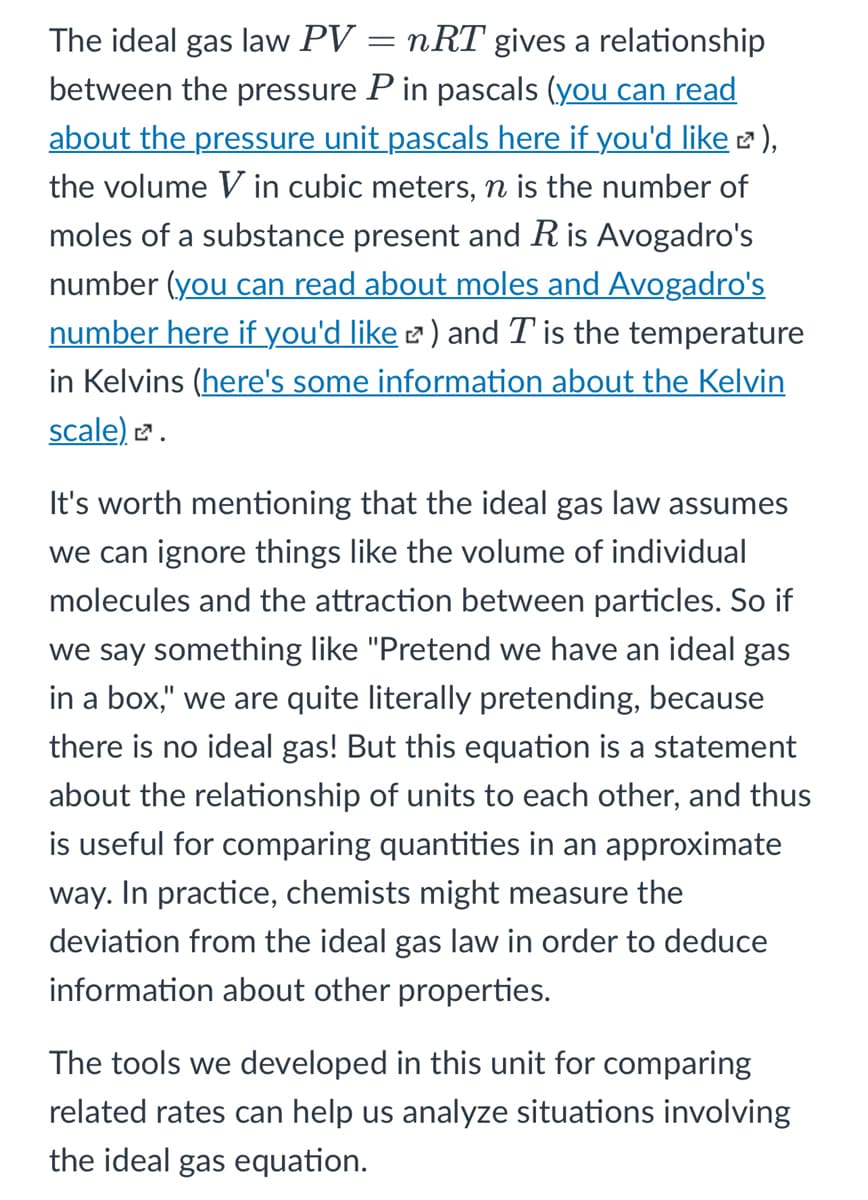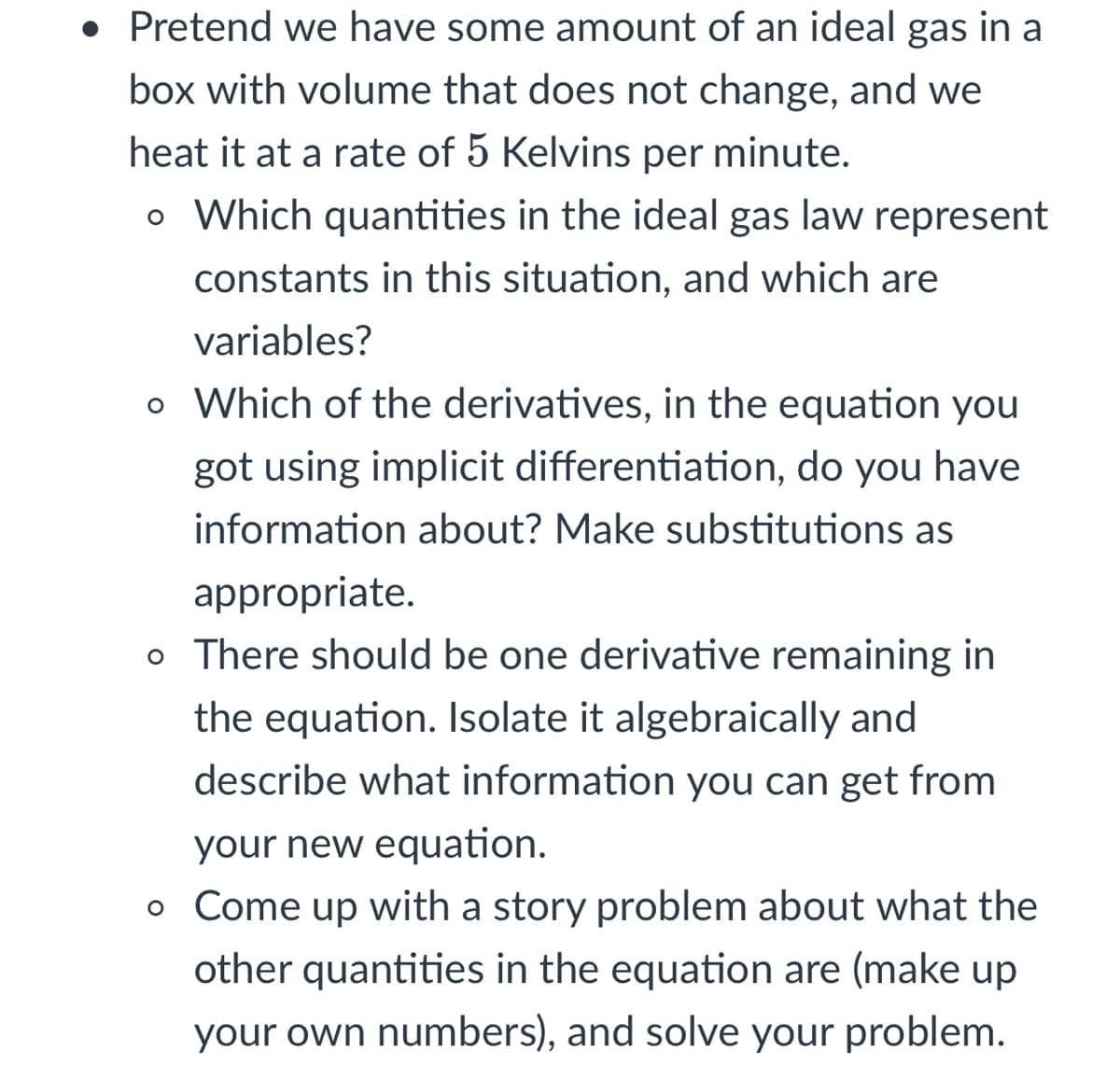• Pretend we have some amount of an ideal gas in a box with volume that does not change, and we heat it at a rate of 5 Kelvins per minute. o Which quantities in the ideal gas law represent constants in this situation, and which are variables? o Which of the derivatives, in the equation you got using implicit differentiation, do you have information about? Make substitutions as appropriate. o There should be one derivative remaining in the equation. Isolate it algebraically and describe what information you can get from your new equation. o Come up with a story problem about what the other quantities in the equation are (make up your own numbers), and solve your problem.
• Pretend we have some amount of an ideal gas in a box with volume that does not change, and we heat it at a rate of 5 Kelvins per minute. o Which quantities in the ideal gas law represent constants in this situation, and which are variables? o Which of the derivatives, in the equation you got using implicit differentiation, do you have information about? Make substitutions as appropriate. o There should be one derivative remaining in the equation. Isolate it algebraically and describe what information you can get from your new equation. o Come up with a story problem about what the other quantities in the equation are (make up your own numbers), and solve your problem.
Chapter2: The Kinetic Theory Of Gases
Section: Chapter Questions
Problem 81AP: One process for decaffeinating coffee uses carbon dioxide ( M=44.0 g/mol) at a molar density of...
Related questions
Question
100%

Transcribed Image Text:The ideal gas law PV = nRT gives a relationship
between the pressure P in pascals (you can read
about the pressure unit pascals here if you'd like 2),
the volume V in cubic meters, n is the number of
moles of a substance present and R is Avogadro's
number (you can read about moles and Avogadro's
number here if you'd like 2 ) and T is the temperature
in Kelvins (here's some information about the Kelvin
scale) 2.
It's worth mentioning that the ideal gas law assumes
we can ignore things like the volume of individual
molecules and the attraction between particles. So if
we say something like "Pretend we have an ideal gas
in a box," we are quite literally pretending, because
there is no ideal gas! But this equation is a statement
about the relationship of units to each other, and thus
is useful for comparing quantities in an approximate
way. In practice, chemists might measure the
deviation from the ideal gas law in order to deduce
information about other properties.
The tools we developed in this unit for comparing
related rates can help us analyze situations involving
the ideal gas equation.

Transcribed Image Text:• Pretend we have some amount of an ideal gas in a
box with volume that does not change, and we
heat it at a rate of 5 Kelvins per minute.
o Which quantities in the ideal gas law represent
constants in this situation, and which are
variables?
o Which of the derivatives, in the equation you
got using implicit differentiation, do you have
information about? Make substitutions as
appropriate.
o There should be one derivative remaining in
the equation. Isolate it algebraically and
describe what information you can get from
your new equation.
o Come up with a story problem about what the
other quantities in the equation are (make up
your own numbers), and solve your problem.
Expert Solution
This question has been solved!
Explore an expertly crafted, step-by-step solution for a thorough understanding of key concepts.
This is a popular solution!
Trending now
This is a popular solution!
Step by step
Solved in 2 steps

Knowledge Booster
Learn more about
Need a deep-dive on the concept behind this application? Look no further. Learn more about this topic, physics and related others by exploring similar questions and additional content below.Recommended textbooks for you


University Physics Volume 1
Physics
ISBN:
9781938168277
Author:
William Moebs, Samuel J. Ling, Jeff Sanny
Publisher:
OpenStax - Rice University


University Physics Volume 1
Physics
ISBN:
9781938168277
Author:
William Moebs, Samuel J. Ling, Jeff Sanny
Publisher:
OpenStax - Rice University